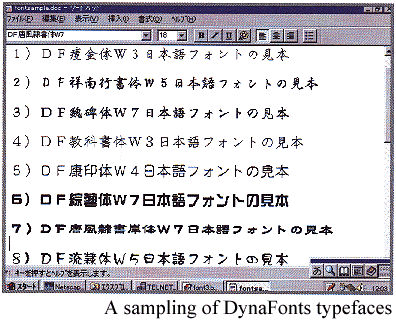Showing Your Best (Type) Face
DynaFont Special Pack,Vol.1:Fifteen Gensen Shotai TrueType Fonts for Windows
reviewed by Steven Myers
If you work with japanese text, sooner or later you're sure to encounter a situation in which the meager selection of fonts provided with Japanese Windows is simply not sufficient for the job at hand. In addition eye-catching kanji fonts for posters, brochures, or catalogs, fonts suited to formal correspondence in Japanese are often a necessity. In particular, the o-reijo(thank-you notes) and aisatsu-bun ("greeting" letters) that are such a critical part of maintaining relationships in Japan call for a more elegant typeface than the ubiquitous-but-drab MS Gothic.
DynaLab's DynaFont Special Pack, Volume 1, is an excellent collection of Japanese TrueType fonts. The two CD-ROM package includes nine kanji typefaces in a total of 15 fonts (some come in varying widths), over 300 "roman" fonts, lots of clip art, and a beta-version Unicode font for Windows 95. Each of the Japanese fonts comes in both fixed-width and proportional-spacing versions, and one (DF Shonan Gyoshotai) has a separate version for tategaki (vertical) writing that connects the kanji to produce a cursive-type effect.

Kanji typefaces tend to impart clear and distinct impressions upon the reader, and many Japanese instinctively associate a typeface with a particular style or feel. The first two fonts shown in the screenshot above, for example (DF Sokintai and DF Shonan Gyoshotai), convey a sense of style and elegance; either would be appropriate for writing a letter of thanks. In contrast, the DF Gihitai font (sample 3) has a "sharp, cutting" feel (and, in fact, is reminiscent of the style used to engrave memorial stones and plaques). The DF Kyokashotai font (sample 4) is traditionally found in Japanese textbooks (hence the name), while DF Shointai (sample 5) is often associated with "coldness" or "loneliness."
DF SogEitai (sample 6) is good for emphasis, but writing an entire letter in this font would be akin to writing in English using all capital letters. The short, wide characters of the Tofu Reishotai font (sample 7) evoke a "classical Chinese" image, while DF Ryureitai (sample 8) possesses a kind of "supernatural, ghostly" quality.
Installation and use of the fonts is simple and straightforward, although there are a few things to watch out for. If you use a Justsystem application, such as Ichitaro or Hanako, it isn't enough to just install the DynaFonts; they must also be registered with the Justsystem program (by clicking on the "font set up" icon in the application's program group). And if you use the Microsoft Plus "gray scale" function, some of the characters may appear smeared and blurry. (Currently there does not seem to be a workaround for this problem.) Finally, note that the sample Unicode font is still in the development stages; it is included strictly for demonstration purposes (meaning that it doesn't work correctly with all characters).
All kanji fonts in the package support the entire JIS Level 1 and Level 2 character sets, and the range of typefaces provides considerable variety. If you want to refine the appearance of your Japanese letters and documents, DynaFont Special Pack, Volume 1, is definitely worth a look.
| To use the DynaFont Special Pack, Volume 1, fonts, you'll need Windows 95J or Windows 3.1J and a CD-ROM drive. Each kanji font uses from 2MB to 6.3MB of hard disk space, and the entire 15-font set requires 62MB. The price is JPY12,800. |
| From DynaLab Japan: |
| phone 03-3224-3180, |
| fax 03-3224-3474. |
